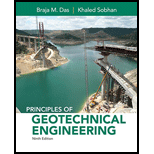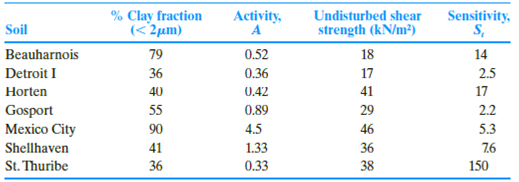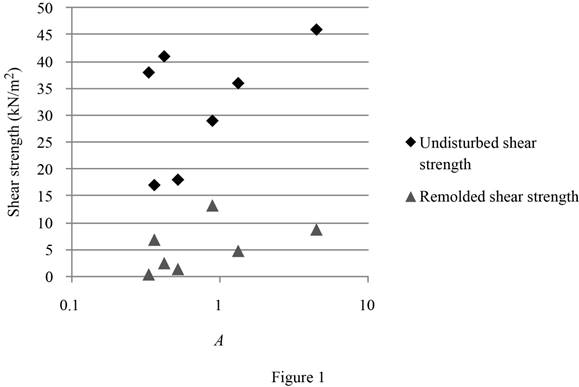
The properties of seven different clayey soils are shown below (Skempton and Northey, 1952). Investigate the relationship between the strength and plasticity characteristics by performing the following tasks:
a. Estimate the plasticity index for each soil using Skempton’s definition of activity [Eq. (4.28)].
b. Estimate the probable mineral composition of the clay soils based on PI and A (use Table 4.3)
c. Sensitivity (St) refers to the loss of strength when the soil is remolded or disturbed. It is defined as the ratio of the undisturbed strength (τf-undisturbed) to the remolded strength (τf-remolded)) at the same moisture content [Eq. (12.49)]. From the given data, estimate τf-remolded for the clay soils.
d. Plot the variations of undisturbed and remolded shear strengths with the activity, A, and explain the observed behavior.

(a)
Find the plasticity index for each soil using Skempton’s definition of activity.
Explanation of Solution
Determine the plasticity index of the Beauharnais soil using the relation.
Here, A is an activity.
Substitute 0.52 for A and 79 for % of clay–size fraction, by weight.
Similarly, calculate the plasticity index for the remaining soils.
Determine the remolded shear strength of the Beauharnais soil using the relation.
Here,
Substitute
Similarly, calculate the remolded shear strength of the remaining soils.
Summarize the calculated values of plasticity index and the remolded shear strength as in Table 1.
| Soil | % Clay fraction | Activity A | Plasticity Index |
| Beauharnois | 79 | 0.52 | 41.08 |
| Detroit I | 36 | 0.36 | 12.96 |
| Horten | 40 | 0.42 | 16.80 |
| Gosport | 55 | 0.89 | 48.95 |
| Mexico City | 90 | 4.5 | 405 |
| Shell haven | 41 | 1.33 | 54.53 |
| St.Thuribe | 36 | 0.33 | 11.88 |
(b)
Find the probable mineral composition of the clay soils based on PI and A.
Explanation of Solution
Determine the probable mineral composition of the clay soils based on PI and A.
Refer Table 4.3, “Typical values of liquid limit, plastic limit, and activity of some clay minerals” in the textbook.
Take the mineral composition of the Beauharnois soil as Illite for the activity value of 0.52 and the plasticity index value of 41.08.
Therefore, the mineral composition of Beauharnois soil is Illite.
Similarly, calculate the probable mineral composition of the remaining soils.
Summarize the calculated values of mineral composition as in Table (2).
| Soil | Activity A | Plasticity Index | Mineral composition |
| Beauharnois | 0.52 | 41.08 | Illite |
| Detroit I | 0.36 | 12.96 | Kaolinite |
| Horten | 0.42 | 16.80 | Kaolinite |
| Gosport | 0.89 | 48.95 | Illite |
| Mexico City | 4.5 | 405 | Montmorillonite |
| Shell haven | 1.33 | 54.53 | Montmorillonite |
| St.Thuribe | 0.33 | 11.88 | Kaolinite |
(c)
Find the remoulded shear strength of the clay soil.
Explanation of Solution
Determine the remoulded shear strength of the Beauharnais soil using the relation.
Here,
Substitute
Similarly, calculate the remolded shear strength of the remaining soils.
Summarize the calculated values of remolded shear strength as in Table 3.
| Soil | Activity A | Undisturbed Shear strength | Sensitivity |
Remoulded Shear strength |
| Beauharnois | 0.52 | 18 | 14 | 1.3 |
| Detroit I | 0.36 | 17 | 2.5 | 6.8 |
| Horten | 0.42 | 41 | 17 | 2.4 |
| Gosport | 0.89 | 29 | 2.2 | 13.2 |
| Mexico City | 4.5 | 46 | 5.3 | 8.7 |
| Shell haven | 1.33 | 36 | 7.6 | 4.7 |
| St.Thuribe | 0.33 | 38 | 150 | 0.3 |
(d)
Plot the variations of undisturbed and remolded shear strengths with the activity A.
Explanation of Solution
Refer Table 3.
Plot the graph between the undisturbed, remolded shear strengths with the activity A as in Figure 1.

The shear strength of the clay obtains from two components, one is cohesion, which is the cementing force between particles, and second one is frictional resistance, which is mainly due to the particle movement of one particle over another. The cohesion contribution is greater to the shear strength, when the clay activity is greater. Although no reliable correlation can be developed from Figure 1, both the undisturbed and remolded shear strengths certainly show increasing trends as the activity increases.
Want to see more full solutions like this?
Chapter 4 Solutions
Principles of Geotechnical Engineering (MindTap Course List)
- The tension in cable BA is 10 kN. The questions will lead you toward determining the moment of the force acting from B to A about the x-axis. Hints: Pay attention to the orientation of the XYZ coordinate axes. 1000 mm A (400, 300, 0) mm 600 mm xarrow_forwardThe beam shown in the figure below is typical for a floor system in an existing building.It needs to carry a uniform live load of 260 lb/ft and a uniform dead weight of 400 lb/ft,including its own weight. The owner wants to add a partition weighing 7 kip (live load) asshown. Assuming the added partition as live load, is the beam section adequate to safelycarry the extra live load?PartitionStirrups15 ft 3 in.14 in.a. Determine the d e s i g n m o m e n t c a p a c i t y .b. D e t e r m i n e t h e f a c t o r e d a p p l i e d b e n d i n g m o m e n t .c. Is the beam safe and adequate for bending? Please explain your response.arrow_forward4. Use the influence function method to draw the influence line for the shear just to the right of A. Assume C is fixed, A is a roller, and B is a pin. 8 ft A 16 ft B 10 ft-arrow_forward
- 4-39. Draw the shear and moment diagrams for each of the three members of the frame. Assume the frame is pin connected at A, C, and D and there is a fixed joint at B. 4 m 50 kN 40 kN -1.5 m -2 m 1.5 B 15 kN/m 6 m Darrow_forwardAggregates from three sources having the properties shown in Table P5.41were blended at a ratio of 25:60:15 by weight. Determine the properties of theaggregate blend.arrow_forward7-7. Determine the equations of the elastic curve for the beam using the x and x, coordinates. Specify the beam's maximum deflection. El is constant. 22arrow_forward
- The cantilever beam shown below supports a uniform service (unfactored) dead load of 1.5 kip/ft plus its own self weight, plus two unknown concentrated service (unfactored) live loads, as shown. The concrete has f’c = 6,000 psi and the steel yield strength is 60 ksi. a. Determine the design moment capacity. b. Set up the applied bending moment capacity. c. Calculate maximum safe concentrated live load that the beam may carry.arrow_forwardThe circular slab of radius r supported by four columns, as shown in figure, is to be isotropically reinforced. Find the ultimate resisting moment (m) per linear meter required just to sustain a concentrated factored load of P kN applied at the center of the slab. Solve by using equilibrium m m Columnarrow_forwardBy using the yield line theory, determine the ultimate resisting moment per linear meter (m) for an isotropic reinforced concrete two-way simply supported polygon slab shown in figure under a uniform load (q). Solve by using equilibrium method m marrow_forward
- By using the yield line theory, determine the ultimate resisting moment per linear meter (m) for an isotropic reinforced concrete two-way simply supported polygon slab shown in figure under a concentrated factored load of P. Solve by Using equilibrium method m m 8/arrow_forwardH.W: Evaluate the integral 1. 30 √ · √(x²y – 2xy)dydx 0-2 3 1 3. (2x-4y)dydx 1-1 2π π 5. (sinx + cosy)dxdy π 0 0 1 ƒ ƒ (x + 2. +y+1)dxdy 4. -1-1 41 ][ 20 x²ydxdyarrow_forwardExample 5 By using the yield line theory, determine the moment (m) for an isotropic reinforced concrete two-way slab (supports on two S.S sides shown in figure under the load (P) (all dimensions are in mm). Solve by using equilibrium method Please solve by using equilibrium method m m 3000 2000 2000arrow_forward
 Principles of Geotechnical Engineering (MindTap C...Civil EngineeringISBN:9781305970939Author:Braja M. Das, Khaled SobhanPublisher:Cengage Learning
Principles of Geotechnical Engineering (MindTap C...Civil EngineeringISBN:9781305970939Author:Braja M. Das, Khaled SobhanPublisher:Cengage Learning Principles of Foundation Engineering (MindTap Cou...Civil EngineeringISBN:9781337705028Author:Braja M. Das, Nagaratnam SivakuganPublisher:Cengage Learning
Principles of Foundation Engineering (MindTap Cou...Civil EngineeringISBN:9781337705028Author:Braja M. Das, Nagaratnam SivakuganPublisher:Cengage Learning Fundamentals of Geotechnical Engineering (MindTap...Civil EngineeringISBN:9781305635180Author:Braja M. Das, Nagaratnam SivakuganPublisher:Cengage Learning
Fundamentals of Geotechnical Engineering (MindTap...Civil EngineeringISBN:9781305635180Author:Braja M. Das, Nagaratnam SivakuganPublisher:Cengage Learning Principles of Foundation Engineering (MindTap Cou...Civil EngineeringISBN:9781305081550Author:Braja M. DasPublisher:Cengage Learning
Principles of Foundation Engineering (MindTap Cou...Civil EngineeringISBN:9781305081550Author:Braja M. DasPublisher:Cengage Learning Construction Materials, Methods and Techniques (M...Civil EngineeringISBN:9781305086272Author:William P. Spence, Eva KultermannPublisher:Cengage Learning
Construction Materials, Methods and Techniques (M...Civil EngineeringISBN:9781305086272Author:William P. Spence, Eva KultermannPublisher:Cengage Learning Traffic and Highway EngineeringCivil EngineeringISBN:9781305156241Author:Garber, Nicholas J.Publisher:Cengage Learning
Traffic and Highway EngineeringCivil EngineeringISBN:9781305156241Author:Garber, Nicholas J.Publisher:Cengage Learning





